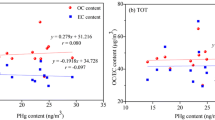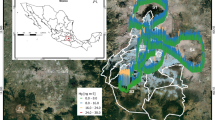Abstract
Large-scale assessment of atmospheric air pollution by mercury (Hg) using lichen Parmelia caperata as biological indicator was undertaken using samples from five provinces of South Africa collected between 2013 and 2017. Analysis of lichens provides time-integrated data, which correspond to the mean Hg concentration in air at a specific location over a long time period. Determination of Hg in lichens was carried out by direct thermal decomposition of samples using a Zeeman-effect atomic absorption spectrometer, thereby requiring no chemical pretreatment. The lowest mercury concentration of 60 ± 8.0 ng g−1 (n = 45) was measured in lichens from Limpopo province. This value was accepted as a background Hg concentration in SA lichens. The Hg in lichens from northern parts of Mpumalanga province varied from 72 ± 9.0 to 100 ± 17 ng g−1 (n = 45), while in southern parts of the province, where 11 coal-fired electrical power stations are located, values ranged from 139 ± 7.0 to 183 ± 10 ng g−1 (n = 28). The highest Hg concentration, 218 ± 21 ng g−1 (n = 10), was found in lichens from Secunda, Mpumalanga province. It could be traced to the possible Hg emission during thermal treatment of coal at the largest SA industrial plant that transforms coal into liquid fuels. In Pretoria and Johannesburg, cities in Gauteng province, Hg in lichens was between 110 and 162 ng g−1 (n = 48). Based on the results of measurements, the equation connecting Hg concentration in lichens with Hg concentration in air has been derived. It was used for the calculation of atmospheric Hg concentration in South African provinces. Calculated values (0.8–1.45 ng m−3) were found to be within statistical summary of mean atmospheric Hg in remote places (1.70 ± 0.17 ng m−3), and in other locations (1.5–3.0 ng m−3) lower than in impacted areas of the world (5.20 ± 3.47 ng m−3).


Similar content being viewed by others
References
Armstrong, A. R., & Bradwell, T. (2011). Growth of foliose lichens: A review. Symbiosis, 53, 1–16.
Bargagli, R. (2016). Moss and lichen biomonitoring of atmospheric mercury: A review. Science of Total Environment, 572, 216–231.
Bargagli, R., Monaci, F., Borghini, F., Bravi, F., & Agnorelli, C. (2002). Mosses and lichens as biomonitors of trace metals. A comparison study on Hypnum cupressiforme and Parmelia caperata in a former mining district in Italy. Environmental Pollution, 116, 279–287.
Bennett, J. P., & Wetmore, C. M. (1999). Geothermal elements in lichens of Yellowstone National Park, USA. Environmental and Experimental Botany, 42, 191–200.
Brunker, E.-G., Walters, C., Mkololo, T., Martin, L., Labuschagne, C., Silwana, B., et al. (2016). Mercury in the atmosphere and in rainwater at Cape Point, South Africa. Atmospheric Environment, 125, 24–32.
Burger, J., Stern, A., & Gochfeld, M. (2005). Mercury in commercial fish. Optimizing choices to reduce risk. Environmental Health Perspective, 113, 266–271.
Dabrowski, J. M., Ashton, P. J., Murray, K., Leaner, J. J., & Robert, P. M. (2008). Anthropogenic mercury emissions in South Africa: Coal combustion in power plants. Atmospheric Environment, 42, 6620–6626.
EN 15852. (2010). Ambient air quality—Standard method for the determination of total gaseous mercury. http://www.en-standard.eu/csn-en-15852-ambient-air-quality-standard-method-for-the-determination-of-total-gaseous-mercury/. Accessed 28 June 2013.
Esbri, J. M., Lopez- Berdonces, M. A., Fernandez-Calderon, S., Higueras, P., & Diez, S. (2015). Atmospheric mercury pollution around a chlor-alkali plant in Flix (NE Spain): An integrated analysis. Environmental Science and Pollution Research, 22, 4842–4850.
Ferrara, R., Masert, B. E., & Bargagli, R. (1988). Mercury in the atmosphere and in lichens in a region affected by geochemical anomaly. Environmental Technology Letters, 9, 689–694.
Ferrara, R., Maserti, B. E., Anderson, M., Edner, H., Ragnarson, P., Svanberg, S., et al. (1998). Atmospheric mercury concentrations and fluxes in the Almaden district (Spain). Atmospheric Environment, 32, 3897–3904.
Fu, X., Feng, X., & Zhu, W. (2009). Temporal and spatial distributions of TGM in Gongga mountain area, Sichuan province, P.R. China: Regional sources and long-range atmospheric transport. Science of Total Environment., 42, 2306–2314.
Garnham, B. L., & Langerman, K. E. (2016). Mercury emission from South Africa’s coal fired power stations. Clean Air, 26, 14–20.
Garty, J. (2001). Biomonitoring atmospheric heavy metals with lichens: Theory and application. Critical Reviews in Plant Sciences, 20(4), 309–371.
Grangeon, S., Guédron, S., Asta, J., Sarret, G., & Charlet, L. (2012). Lichen and soil as indicators of an atmospheric mercury contamination in the vicinity of a chlor-alkali plant (Grenoble, France). Ecological Indicators, 13, 178–183.
Gworek, B., Dmuchowski, W., Baczewska, A. H., Bragoszewska, P., Bemowska-Kalabun, O., & Wrzosek-Jakubowska, J. (2017). Air contamination by mercury, emissions and transformations—a review. Water, Air, and Soil pollution, 228(123), 1–31.
Higueras, P., Oyarzun, R., Kotnik, J., Esbrí, J. M., Martínez-Coronado, A., & Horvat, M. (2014). A compilation of field surveys of gaseous elemental mercury (GEM) from contrasting environmental settings in Europe, South America, South Africa and China: separating fads from facts. Environmental Geochemistry and Health, 36, 713–734.
Horvat, M., Jeran, Z., Špiric, Z., Jacimovic, R., & Miklavcic, V. (2000). Mercury and other elements in lichens near the INA Naftaplin gas treatment plant, Molve, Croatia. Journal of Environmental Monitoring, 2(2), 139–144.
Hu, Y., & Cheng, H. (2016). Control of mercury emissions from stationary coal combustion sources in China: Current status and recommendations. Environmental Pollution, 218, 1209–1221.
Kim, K.-H., Mishra, V. K., & Hong, S. (2006). The rapid and continuous monitoring of gaseous elemental mercury (GEM) behaviour in ambient air. Atmospheric Environment, 40, 3281–3293.
Lodenius, M. (1981). Regional distribution of mercury in Hypogymnia physodes in Finland. Ambio, 10, 183–184.
Lokken, J. A., Finstad, G., Dunlap, K., & Duffy, L. K. (2009). Mercury in lichens and reindeer hair from Alaska: 2005–2007 pilot survey. Polar Star, 45, 368–374.
Lopez-Berdonces, M. A., Higueras, P. L., Fernández-Pascual, M., Borreguero, A. M., & Carmona, M. (2016). The role of native lichens in the biomonitoring of gaseous mercury at contaminated sites. Journal of Environmental Management, 186, 207–213.
Loppi, S., & Printsos, S. A. (2003). Epiphytic lichens as sentinels for heavy metal pollution at forest ecosystems (central Italy). Environmental Pollution, 121, 327–332.
Makholm, M. M., & Bennet, J. P. (1998). Mercury accumulation in transplanted Hypogymnia physodes lichens downwind of Wisconsin chlor-alkali plant. Water, Air, and Soil pollution, 102, 427–436.
Masekoameng, K. E., Leaner, J., & Dabrowski, J. (2010). Trends in anthropogenic emission estimated for South Africa during 2000–2006. Atmospheric Environment, 44, 3007–3014.
Mashyanov, N. R., Pogarev, S. E., Panova, E. G., Panichev, N. A., & Ryzhov, V. (2017). Determination of mercury thermospecies in coal. Fuel, 203, 973–980.
Mekonnen, K. N., Ambushe, A. A., Chandravanshi, B. S., Abshiro, M. R., McCrindle, R. I., & Panichev, N. A. (2012). Distribution of mercury in the sediments of some freshwater bodies in Ethiopia. Toxicological Environmental Chemistry, 94, 1678–1687.
Miller, J. N., & Miller, J. C. (2005). Statistics and chemometrics for analytical chemistry (5th ed.). London: Pearson Education Limited.
Molina, J. A., Oyarzun, R., Esbri, J. M., & Higueras, P. (2006). Mercury accumulation in soil and plants in the Almaden mining district, Spain: One of the most contaminated sites on Earth. Environmental Geochemistry and Health, 28, 487–498.
Nicolardi, V., Cai, G., Parrotta, L., Puglia, M., Bianchi, L., Bini, L., et al. (2012). The adaptive response of lichens to mercury exposure involves changes in the photosynthetic machinery. Environmental Pollution, 160, 1–10.
Pacyna, E. G., Pacyna, J. M., Fudała, J., Strzelecka-Jastrząb, E., Hławiczka, S., & Panasiuk, D. (2006). Mercury emissions to the atmosphere from anthropogenic sources in Europe in 2000 and their scenarios until 2020. Science of Total Environment, 370, 147–156.
Pacyna, E. G., Pacyna, J. M., Sundseth, K., Munthe, J., Kindbom, J., & Wilson, S. (2010). Global emission of mercury to the atmosphere from anthropogenic sources in 2005 and projections to 2020. Atmospheric Environment, 44, 2487–2499.
Panday, S. K., Kim, K.-H., & Brown, R. J. C. (2011). Measurement techniques for mercury species in ambient air. Trends in Analytical Chemistry, 30, 899–917.
Panichev, N. A., & Panicheva, S. E. (2015). Determination of total mercury in fish and sea products by direct thermal decomposition atomic absorption spectrometry. Food Chemistry, 166, 432–441.
Paoli, L., Munzi, S., Guttova, A., Senko, D., Sardella, G., & Loppi, S. (2015). Lichens as suitable indicators of the biological effects of atmospheric pollutants around a municipal solid incinerator (S Italy). Ecological Indicators, 52, 3.
Sensen, M., & Richardson, D. H. S. (2002). Mercury levels in lichens from different host trees around a chlor-alkali plant in New Brunswick, Canada. Science of Total Environment, 293, 31–45.
Sholupov, S., & Ganeev, A. (1995). Zeeman atomic absorption spectrometry using high frequency modulated light polarization. Spectrochimica Acta, Part B, 50, 1227–1236.
Sholupov, S., Pogarev, S., Ryzhov, V., Mashyanov, N., & Stroganov, A. (2004). Zeeman atomic absorption spectrometer RA-915+ for direct determination of mercury in air and complex matrix samples. Fuel Process Technology, 85, 473–485.
Sprovieri, F., Pirrone, N., Ebinghouse, R., Kock, H., & Dommergue, A. (2010). A review of worldwide atmospheric mercury measurement. Atmospheric Chemistry and Physics, 10, 8245–8265.
Streets, D. G., Lu, Z., Levin, L., Schure, A. F. H., & Sunderland, E. M. (2018). Historical releases of mercury to air, land, and water from coal combustion. Science of Total Environment, 615, 131–140.
Trüe, A., Panichev, N. A., Okonkwo, J., & Forbes, P. (2012). Determination of the mercury content of lichens and comparison to atmospheric mercury levels in the South African Highveld region. Clean Air Journal, 21, 19–25.
UNEP, 2013. Global Mercury Assessment. (2013). Sources, emissions, releases and environmental transport. Geneva: UNEP Chemical Branch.
Valente, R. J., Shea, C., Humes, K. L., & Tanner, R. L. (2007). Atmospheric mercury in the Great Smoky Mountains compared to regional and global levels. Atmospheric Environment, 41, 1861–1873.
Vannini, A., Nicolardi, V., Bargagli, R., & Loppi, S. (2014). Estimating atmospheric mercury concentrations with lichens. Environmental Science and Technology, 48, 8754–8759.
Wang, Z., Chen, Z., Duan, N., & Zhang, X. (2007). Gaseous elemental mercury concentration in atmosphere at urban and remote sites in China. Journal of Environmental Science, 19, 176–180.
Will-Wolf, S., Jovan, S., & Amacher, M. C. (2017). Lichens elemental content bioindicators for air quality in upper Midwest, USA: A model for large-scale monitoring. Ecological Indicators, 78, 253–263.
Acknowledgements
The authors thank the South African National Research Foundation (NRF) for financial support of the project (Grant No. 81298), Prof Thierry Regnier, Prof Sandra Combrinck and Ph.D. student Ms Mpho Mathebula for help in collection of lichens. We thank the members of the Department of Botany, Pretoria University, for the identification of lichens. We are grateful to both reviewers of this manuscript for useful questions, comments and recommendations which allow us to improve the article’s text.
Author information
Authors and Affiliations
Corresponding author
Additional information
Publisher's Note
Springer Nature remains neutral with regard to jurisdictional claims in published maps and institutional affiliations.
Rights and permissions
About this article
Cite this article
Panichev, N., Mokgalaka, N. & Panicheva, S. Assessment of air pollution by mercury in South African provinces using lichens Parmelia caperata as bioindicators. Environ Geochem Health 41, 2239–2250 (2019). https://doi.org/10.1007/s10653-019-00283-w
Received:
Accepted:
Published:
Issue Date:
DOI: https://doi.org/10.1007/s10653-019-00283-w




